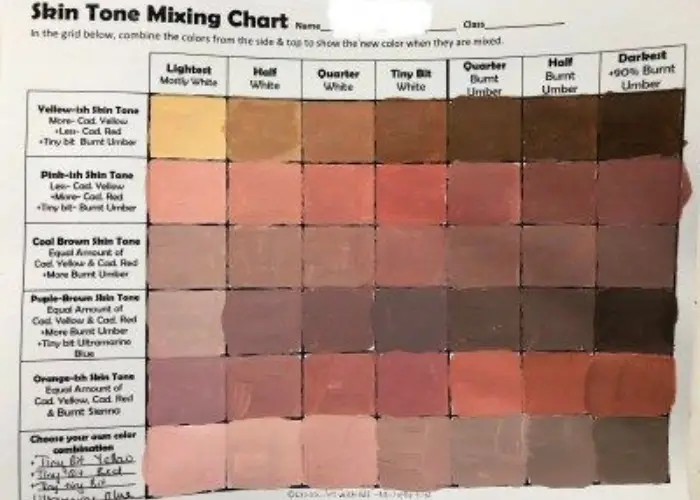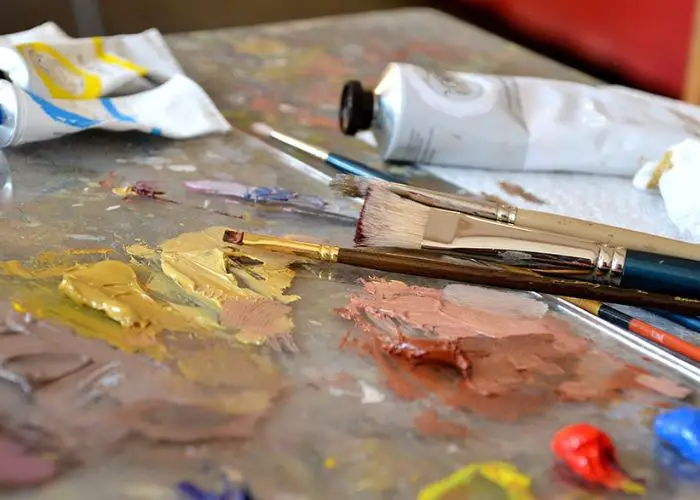When it comes to painting skin tones, there are a few things that you need to take into account.
The first is your skin tone – what is your skin color? The second is the flesh tone – what color should the skin be?
And finally, how can you mix different colors together to create realistic skin tones for your paintings?
In this blog post, we will explore how to make skin color paint using acrylics. We will also look at how to mix different colors together to create realistic skin tones for your paintings.
So, whether you are a beginner or an experienced artist, read on for tips and tricks on painting beautiful skin tones easily!
How to Make Skin Color Acrylic Paint
Start by creating a palette with the three primary colors: yellow, blue, and red. Next, mix together equal parts of each primary color. Once you have your colors mixed together, it’s time to refine your color. To do this, add a tiny bit of white to lighten the skin tone or a tiny bit of black to darken it. You can also add a green or purple touch to create a more realistic skin tone.
What Is My Skin Tone

Have you ever looked in the mirror and wondered, “What is my skin tone?” If so, you’re not alone.
It can be tough to determine your skin tone, especially if you don’t have a lot of experience with makeup or fashion.
However, there are a few key factors that you can use to figure out your skin tone. First, take a look at the underside of your wrists.
You probably have cool-toned skin if your veins appear blue or purple. If they appear green, then you likely have warm-toned skin.
You can also hold a piece of white paper up to your face. If your skin looks better against a white background, then you have cool-toned skin.
You have warm-toned skin if it looks better against a cream or yellow background. Finally, consider whether you tend to burn or tan in the sun.
If you burn easily, then you have cool-toned skin. If you tan easily, then you likely have warm-toned skin.
Determining the Flesh Tone
Now that you know your skin tone, it’s time to determine the flesh tone. The easiest way is to look at your skin in natural light.
Once you have found a good source of light, take a close look at your skin and identify the undertone.
The undertone is the color that comes through your skin. It can be pink, yellow, or even green.
Once you have determined the undertone, you can start to mix colors to create your desired skin tone.
What Colors Make Skin Color?

There are a few different colors that you can use to create realistic skin tones. The most important colors are the primaries: red, yellow, and blue.
These colors can be mixed in different proportions to create a wide range of skin tones.
In addition to the primaries, you will also need white and black paint to lighten or darken your colors as needed.
How to Make Skin Color Acrylic Paint
Below is a step-by-step guide on how to make skin color paint using acrylics:
Step one: Creating a palette with the primary colors
To get started, you will need to create a palette with the three primary colors: red, yellow, and blue.
You can use any type of paint that you like, but we recommend using acrylics because they are easy to work with and dry quickly.
Step two: Mix equal parts of each primary color
Once you have your paints, mix together equal parts of each primary color. While mixing, think about the undertone that you want to create.
For example, if you want to create a pink undertone, you will need to use more red than yellow or blue.
Step three: Now, it’s time to refine your color
Now that you have your basic color mixed, it’s time to refine it. To do this, you will need to add white or a color mix to make black to lighten or darken the color as needed.
You can also add a touch of one of the other primary colors if you want to change the undertone.
For example, if you want to create a more peachy color, you can add a touch of yellow.
Let’s now make different shades of skin color:
How to Make Light Skin Color Paint
Now that you know how to mix the basic colors together let’s take a look at how to make light skin color paint.
You will need to add white paint to your palette to lighten your paint. Start with a small amount and gradually add more until you have reached the desired lightness. (Here’s how to make the color white with paint).
How to Make Peach Skin Color Paint
Peach skin color is made by adding a touch of pink or orange to a light skin tone.
To create peach color, start with a light skin tone and add a small amount of pink or orange paint.
Peach skin color is made by adding a touch of pink or orange to a light skin tone.
To create peach color, start with a light skin tone and add a small amount of pink or orange paint.
If you are interested in how to make peach skin color darker, then you can use more pink or orange paint to create a deeper shade.
How to Make a Tan Skin Color With Paint
A tan skin color is made by adding brown-yellow paint to a light skin tone.
Knowing what colors make tan skin tone is not enough, however. You will also need to know what type of paint to use, how much of each color to add, and the techniques for combining them.
Start with a light skin tone and add small amounts of brown or yellow paint. If you want to make a more golden color, add a touch of orange.
How to Make Skin Color With Oil Paints
Oil paints are known for their ability to create realistic skin tones. However, they can be tricky to work with if you are unfamiliar with them.
Fortunately, you can use a simple technique to create a realistic skin color with oil paints. First, start with a light base color.
Then add in a second color that is slightly darker. Finally, add a third color that is even darker. To create different shades of skin, simply vary the proportions of each color.
For example, if you wanted to create a light skin tone, you would use more of the light base color and less of the darker colors.
Conversely, if you wanted to create a dark skin tone, you would use more of the dark colors and less of the light base color.
How to Make Skin Color with Watercolors
The how-to-make Skin Color with Watercolors will guide you through mixing colors to create the perfect shade for your subject.
Start with a light beige color on your palette and add a touch of yellow. If the mixture is too light, add a bit of pink or peach.
Mix in a tiny amount of brown or orange for a more tanned look. If the color is too dark, add more white until you have achieved the desired skin tone.
Painting Skin Tones
Now that you know how to mix the perfect skin color, it’s time to put it to use. When painting skin tones, it’s important to remember that there is a lot of variation in human skin.
To create realistic skin tones, you will need to paint different shades and hues of color.
Painting light skin tones
When painting light skin tones, it’s important to use a variety of colors.
- Start with a light beige color and then add a yellow touch.
- If the mixture is too light, add a bit of pink or peach. Mix in a tiny amount of brown or orange for a more tanned look.
- If the color is too dark, add more white until you have achieved the desired skin tone.
Painting medium skin tones
When painting medium skin tones, you will want to mix together a variety of colors.
Some of the colors you may want to use include yellow, orange, red, brown, and white. You will want to mix these colors until you have achieved the desired shade.
One way to create medium skin tones is to start with a light base color. Then, add in some orange and red until you have achieved the desired shade.
You can also add in some brown to create a more tanned look. Another way to create medium skin tones is to start with a yellow base color.
Then, add in some orange and red until you have achieved the desired shade. You may also want to add in some white to lighten the color.
Once you have mixed together the colors, it is time to start painting.
- Begin by painting a small section of the skin tone you wish to achieve.
- Then, slowly add more paint until you have covered the entire area.
- Remember, when painting skin tones, it is important to experiment with different colors and shades. This will help you find the perfect color for your painting.
Painting dark skin tones
Painting dark skin tones can be a bit tricky. This is because there is a lot of variation in human skin. To create realistic dark skin tones, you will need to use a variety of colors.
One way to create dark skin tones is to start with a dark brown or black base color. Then, add in some red, orange, and yellow until you have achieved the desired shade.
You may also want to add in some white to lighten the color. Another way to create dark skin tones is to start with a dark brown or black base color.
Then, add in some red and orange until you have achieved the desired shade. You can also add in some white to lighten the color.
Once you have mixed together the colors, it is time to start painting.
- Begin by painting a small section of the skin tone you wish to achieve.
- Then, slowly add more paint until you have covered the entire area.
Skin Color Mixing Chart
The following chart shows the various colors that can be mixed together to create different shades of skin tone. Use this as a guide when creating your own custom colors.

Light Skin Tone:
- White
- Yellow
- Pink or peach (optional)
Medium Skin Tone:
- Yellow
- Orange
- Red
- Brown (optional)
- White (optional)
Dark Skin Tone:
- Dark brown or black
- Red
- Orange
- Yellow (optional)
- White (optional)
Variations in Painting Skin Tones
In addition to the three main skin tones, there are also variations that can be created. These include blush tones, tinted light skin tones, and more.
Creating blush tones
To create a blush tone, mix together a small amount of pink or peach with your light skin tone color.
Then, add in a touch of white until you have achieved the desired shade.
Tinted light skin tones
To create a tinted light skin tone, mix together your light skin tone color with a small amount of white.
Then, add in a touch of color (such as pink or peach) until you have achieved the desired shade.
“What color does orange and white make when mixed?” Read this article as a helpful tip to guide you in achieving desired shades for your skin tone.
Tips on How to Make Skin Color With Paint
- When mixing colors to create a skin tone, it is important to start with small amounts of each color. This will help you avoid making the color too dark or light. You can always add more paint if needed.
- It is also important to experiment with different colors and shades. This will help you find the perfect color for your painting.
- Finally, when painting skin tones, it is important to use a variety of colors. This will help you create realistic and believable skin tones.
Best Skin Tone Acrylic Paint Set?
There is no one “best” skin tone acrylic paint set. However, there are several sets that are well-suited for painting skin tones.
These sets typically include a variety of colors, such as white, yellow, pink, peach, red, orange, brown, and black.
Experiment with different sets until you find the one that works best for you. We have reviewed a few of our favorite skin tone acrylic paint sets below.
1. Dark Flesh Tone Acrylic Paint Set
With this Dark Flesh Tone Acrylic Paint Set, you can create stunning artworks with beautiful flesh tones.
The set includes three popular colors – beige, brown, and burnt umber – perfect for achieving realistic skin tones.
Each color is highly pigmented and easy to blend, so you can create exactly the look you want. Plus, the paint is water-based and non-toxic, making it safe for everyone to use.
Whether you’re a beginner or a professional artist, this paint set is a great choice for creating beautiful paintings with lifelike skin tones.
2. Craft Smart Acrylic Paint Skin Tone Colors
Introducing the newest addition to your painting supplies – Craft Smart Acrylic Paint Skin Tone Colors!
This versatile set of colors is perfect for any skin tone, whether you’re looking to create a natural look or something more adventurous.
The set includes three beautiful colors – tan, golden, and brown – that can be mixed and matched to create any shade you desire.
They’re perfect for both beginners and experienced painters alike. And because they’re acrylics, they’re easy to use and clean up.
So what are you waiting for? Get crafty with craft smart acrylic paint skin tone colors!
FAQs
How to make skin colour with acrylic paint?
To make skin color with acrylic paint, mix together a small amount of each primary color (yellow, red, and blue). Then, add in a touch of white until you have achieved the desired shade. You can also add a small amount of pink or peach for light skin tones.
What paint do I mix to make skin color?
The paints to mix to make skin color depend on the skin tone you want to create. For light skin tones, mix together yellow, white, and a small amount of pink or peach. Mix yellow, white, red, and brown for medium skin tones. For dark skin tones, mix together brown, black, and white.
How can I make skin tone?
There are a few ways to make skin tone. One way is to mix together a small amount of each primary color (yellow, red, and blue). Another way is to use a commercially available skin tone paint set. Finally, you can also create your own custom skin tone by mixing together different colors until you achieve the desired shade.
How do you paint realistic skin with acrylics?
To paint realistic skin with acrylics, you’ll need to start with a basic understanding of skin tones. First, you’ll need to determine your subject’s flesh tone. This can be done by looking at the veins in their wrist or by holding a white piece of paper up to their face and seeing which color stands out most. Once you’ve determined the flesh tone, it’s time to mix together the colors that will make up the skin color.
Conclusion
Now that you know how to make skin color acrylic paint, it’s time to get creative!
Use the colors and techniques described in this article to create beautiful paintings with lifelike skin tones.
Experiment with different colors and mixes until you find the perfect shade for your artwork. And don’t forget to have fun!
Painting is supposed to be enjoyable, so make sure you take the time to enjoy it. Thanks for reading! We hope this article was helpful. Happy painting!










Leave a Reply